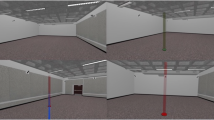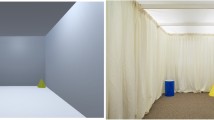Abstract
Virtual reality (VR) technology is increasingly used in spatial cognition research, as it offers high experimental control and interactivity in naturalistic multi-modal environments, something that is difficult to achieve in real-world settings. Even in the most sophisticated and costly VR systems, people do not necessarily perceive and behave as they would in the real world. This might be related to our inability to use embodied (and thus often highly automated and effective) spatial orientation processes in VR. While real-world locomotion affords automatic and obligatory spatial updating of our self-to-surrounding relationships, such that we easily remain oriented during simple perspective changes, the same is not necessarily true in VR. This can lead to striking systematic and qualitative errors such as failures to update rotations (“Nonturner” behavior). Here, we investigated whether rich naturalistic visual stimuli in immersive VR might be sufficient to compensate for the lack of physical motion. To this end, 24 participants performed point-to-origin tasks after visually simulated excursions along streets of varying curvature in a naturalistic virtual city. Most (21/24) participants properly updated simulated self-motions and showed only moderate regression toward mean pointing responses. 3/24 participants, however, exhibited striking “Nonturner” behavior in that they pointed as if they did not update the visually simulated turns and their heading had not changed. This suggests that our immersive naturalistic VR stimuli were an improvement over prior optic flow stimuli, but still insufficient in eliciting obligatory spatial updating that supported correct point-to-origin responses in all participants.



Similar content being viewed by others
References
Avraamides MN, Kelly JW (2008) Multiple systems of spatial memory and action. Cogn Process 9:93–106. doi:10.1007/s10339-007-0188-5
Avraamides MN, Klatzky RL, Loomis JM, Golledge RG (2004) Use of cognitive versus perceptual heading during imagined locomotion depends on the response mode. Psychol Sci 15:403–408. doi:10.1111/j.0956-7976.2004.00692.x
Farrell MJ, Robertson IH (1998) Mental rotation and the automatic updating of body-centered spatial relationships. J Exp Psychol Learn Mem Cogn 24:227–233
Gramann K (2012) Embodiment of spatial reference frames and individual differences in reference frame proclivity. Spat Cogn Comput. doi:10.1080/13875868.2011.589038
Gramann K, Muller HJ, Eick EM, Schonebeck B (2005) Evidence of separable spatial representations in a virtual navigation task. J Exp Psychol Hum Percept Perform 31:1199–1223
Gramann K, Wing S, Jung T-P et al (2012) Switching spatial reference frames for yaw and pitch navigation. Spat Cogn Comput 12:159–194. doi:10.1080/13875868.2011.645176
Klatzky RL, Loomis JM, Beall AC et al (1998) Spatial updating of self-position and orientation during real, imagined, and virtual locomotion. Psychol Sci 9:293–298. doi:10.1111/1467-9280.00058
Loomis JM, Klatzky RL, Golledge RG, Philbeck JW (1999) Human navigation by path integration. In: Golledge RG (ed) Wayfinding behavior: cognitive mapping and other spatial processes. Johns Hopkins, Baltimore, pp 125–151
Riecke BE (2008) Consistent left-right reversals for visual path integration in virtual reality: more than a failure to update one’s heading? Presence Teleoperators Virtual Environ 17:143–175. doi:10.1162/pres.17.2.143
Riecke BE (2012) Are left-right hemisphere errors in point-to-origin tasks in VR caused by failure to incorporate heading changes? Spat Cogn 2012 conference (accepted full paper), pp 1–20
Riecke BE, von der Heyde M, Bülthoff HH (2005) Visual cues can be sufficient for triggering automatic, reflex-like spatial updating. ACM Trans Appl Percept (TAP) 2:183–215. doi:10.1145/1077399.1077401
Riecke BE, Cunningham DW, Bülthoff HH (2007) Spatial updating in virtual reality: the sufficiency of visual information. Psychol Res 71:298–313. doi:10.1007/s00426-006-0085-z
Sigurdarson S, Milne AP, Feuereissen D, Riecke BE (2012) Can physical motions prevent disorientation in naturalistic VR? IEEE Virtual Real 2012:31–34. doi:10.1109/VR.2012.6180874
Wiener JM, Mallot HA (2006) Path complexity does not impair visual path integration. Spat Cogn Comput 6:333–346. doi:10.1207/s15427633scc0604_3
Acknowledgments
We thank NSERC for funding and Daniel Feuereissen for technical help.
Conflict of interest
This supplement was not sponsored by outside commercial interests. It was funded entirely by ECONA, Via dei Marsi, 78, 00185 Roma, Italy.
Author information
Authors and Affiliations
Corresponding author
Rights and permissions
About this article
Cite this article
Riecke, B.E., Sigurdarson, S. & Milne, A.P. Moving through virtual reality without moving?. Cogn Process 13 (Suppl 1), 293–297 (2012). https://doi.org/10.1007/s10339-012-0491-7
Published:
Issue Date:
DOI: https://doi.org/10.1007/s10339-012-0491-7




